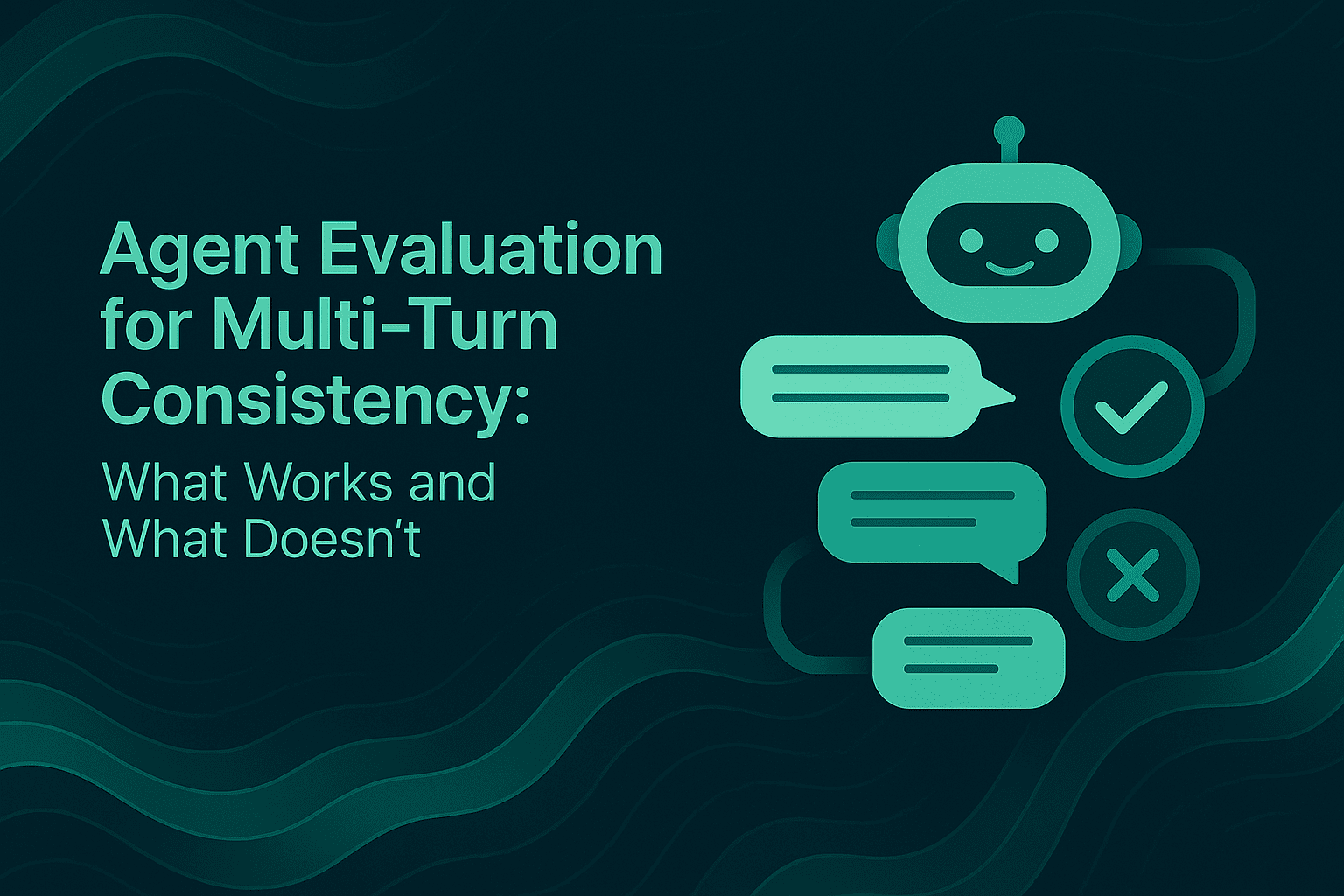Agent Evaluation for Multi-Turn Consistency: What Works and What Doesn’t

TL;DR:
Multi-turn AI agents need layered evaluation metrics to maintain consistency and prevent failures. Successful evaluation combines session-level outcomes (task success, trajectory quality, efficiency) with node-level precision (tool accuracy, retry behavior, retrieval quality). By integrating LLM-as-a-Judge for qualitative assessment, running realistic simulations, and closing the feedback loop between testing and production, teams can catch regressions early, diagnose root causes, and ship reliable agents at scale.
AI agents today do more than answer single questions. They hold conversations, plan steps, call tools, and adapt to changing inputs. This makes evaluations harder, but also more important. Consistency means similar inputs produce similar behavior across turns and tools. When consistency breaks, users see drift, loops, or partial completions that erode trust. This article shows how a small set of practical metrics shines light on real problems, how teams close the feedback loop, and how evaluations improve multi-turn reliability over time.
Why Multi-Turn Consistency Matters
In multi-turn interactions, an agent maintains context, updates plans, selects tools, and produces outputs that build on prior steps. Breakdowns rarely come from a single response. They accumulate across turns when the agent loses the thread, retries in unhelpful ways, or picks the wrong tool at a critical step. Evaluations should reflect this reality with signals at both the session level and the node level. In simple terms, a session is the whole conversation, and a node is a single step inside it, such as a retrieval, a tool call, or a plan update.
Maxim AI's evaluation approach emphasizes layered metrics that mirror real-world agent behavior, pairing session-level outcomes with node-level precision so teams can detect regressions early and tune the system where it actually fails. That combination is central to dependable agent evaluation and aligns with the platform's integrated model of simulation, evals, and observability.
The Feedback Loop: From Signals to Improvements
A strong feedback loop starts with repeatable measurements, connects those signals to root causes, and ends with changes that prevent recurrences. The loop is straightforward:
- Collect metrics on realistic scenarios. Use multi-turn simulations with personas and defined success criteria so measurements reflect how users truly interact.
- Diagnose failures where they begin. Tie session outcomes to the specific steps that made or broke progress.
- Make targeted updates. Adjust prompts, tool routing policies, or error handling at the steps that matter.
- Re-run and compare. Confirm improvements across versions and watch for side effects in latency, cost, or safety.
This loop needs evaluators that scale and still capture nuance. LLM-as-a-Judge adds qualitative judgment under a well-defined rubric, producing reasoned scores at speed while preserving repeatability and transparency. Grounding rubrics and evaluator outputs inside your evaluation suite lets you measure clarity, faithfulness, and coherence alongside deterministic checks. A detailed overview of how rubric-driven LLM evaluations work in production is available in the article: LLM-as-a-Judge in Agentic Applications: Ensuring Reliable and Efficient AI Evaluation.
The Metrics That Actually Move Reliability
| Layer | What It Measures | Why It Matters | Example Signal |
|---|---|---|---|
| Session-Level | Overall task success, trajectory quality, and efficiency | Reveals if the agent completed goals under real conditions | Success rate, trajectory loops, latency, cost |
| Node-Level | Precision at each step (tools, reasoning, retrieval) | Pinpoints where workflows fail or regress | Tool-call validity, retry rates, retrieval relevance |
| LLM-as-a-Judge | Qualitative clarity, coherence, and faithfulness | Captures nuance manual reviews miss, with scalable grading | Clarity score, faithfulness score, rationale |
Session-Level Metrics: Did the interaction succeed and stay on track?
Session-level metrics answer whether the agent achieved the goal under realistic constraints, and whether it stayed efficient and user-appropriate throughout. These are the promotion and reporting layers for release decisions.
- Task success: Clear pass criteria for each scenario. For example, a billing support flow is successful only if the agent authenticates, validates payment, and confirms the order with a final statement that matches policy. Simple success rates, tracked nightly, reveal drift across versions.
- Trajectory quality: Detect loops or unnecessary detours. If the agent repeats "search then summarize" without moving to the next step, tighten the stopping criteria or adjust the plan prompts to progress. Trajectory scores help separate unlucky edge cases from systematic planning issues.
- Consistency across turns: Stability when new information arrives. If a user changes a parameter, the plan should update without losing context. Measurable consistency prevents agents from oscillating between paths.
- Recovery behavior: Self-aware detection and correction when a tool fails. Track whether the agent backs off, switches fallbacks, or asks clarifying questions within allowed budgets.
- Efficiency envelope: End-to-end latency, tokens, and cost. Even good outcomes can be too slow or expensive. Efficiency keeps agent reliability practical at scale.
Example: After a model upgrade, daily session success drops from 93 percent to 86 percent, with a spike in total tokens. Trajectory logs show more planning turns per session. A targeted prompt adjustment reduces planning verbosity and restores success to 92 percent while cutting token usage by 18 percent.
Node-Level Metrics: Where exactly did the workflow go wrong?
Node-level metrics analyze each step for precision, tool discipline, and utility. These are the root-cause layer that explains session behavior.
- Tool-call validity and accuracy: Check arguments, required fields, and outputs against ground truth when available. If a catalog filter misses required SKU attributes, you can pinpoint it to the precise call and fix the schema or mapping.
- Retry behavior and fallbacks: Inspect backoff times and error classes if retries are too aggressive on transient 4xx responses, tune policies to avoid latency blowups.
- Retrieval quality: Measure relevance and duplication for context-dependent steps. If plan updates rely on stale or duplicated context, you may improve ranking or add de-duplication.
- Reasoning step utility: Score whether each plan or explanation step contributes to the outcome. Eliminate "re-explain" steps that consume tokens without moving the task forward.
Example: A rise in end-to-end latency correlates with node-level data showing increased retries on a knowledge API. Policies are updated to cap retries and route to a cached fallback on specific error codes. Latency falls by 23 percent with no drop in task success.
Using LLM-as-a-Judge to Capture Nuance
Many important qualities are not binary. Clarity means the response explains steps plainly. Faithfulness means the output aligns with the provided context and avoids unsupported claims. Coherence means the explanation flows logically turn to turn. LLM-as-a-Judge combines a rubric with a language model to score these dimensions and provide short rationales. This approach scales beyond manual reviews, complements deterministic checks, and helps teams audit why scores changed. The article "LLM-as-a-Judge in Agentic Applications: Ensuring Reliable and Efficient AI Evaluation" outlines how rubrics, few-shot examples, and reasoning prompts produce repeatable, transparent evaluations that integrate into an end-to-end assessment stack.
Example: A troubleshooting agent produces correct steps but confusing phrasing. LLM-as-a-Judge clarity scores highlight issues, and the team revises prompt style guides to favor numbered steps and explicit confirmations. User-facing clarity improves, and session success rises modestly without extra tokens.
Closing the Loop in Practice
You can operationalize the feedback loop by pairing simulation with observability and keeping evaluator coverage aligned between pre-release and production. In practice:
- Build scenario-driven datasets that reflect real workflows, then evolve them with logs through dataset curation so tests stay representative.
- Attach evaluators at the session, trace, and node levels. Pass inputs, context, and outputs to score granular behavior and keep artifacts auditable.
- Run pre-merge smoke suites and nightly broader runs. Gate promotions on session success, safety adherence, and efficiency thresholds, and enforce critical node checks for tool correctness.
- Trace production behavior with distributed instrumentation and route logs through periodic evaluations. Promote representative failures into the golden test set.
Maxim AI's platform integrates this lifecycle across simulation, evaluators, and observability, with support for multi-turn testing, node-level analysis, and automated quality checks. For teams hardening inputs and policies against risky patterns, Maxim AI provides guidance that fits into evaluators and promotion gates.
Small Examples That Make a Big Difference
- Prompt drift fix: A helpdesk agent starts giving extra background instead of a direct resolution. Session-level clarity scores drop, and step utility flags "re-explain" turns. A prompt constraint is added to prioritize resolution-first responses. Clarity scores rebound, and cost per session falls because extra tokens are removed.
- Tool selection correction: The agent uses a web search for internal data. Tool selection checks show repeated misuse. A simple routing rule checks the query type and selects the internal database tool for account questions. Success rates rise, and latency drops.
- Retrieval de-duplication: A RAG pipeline retrieves overlapping snippets that overload context windows. Retrieval quality metrics report duplication rates. A filter removes near duplicates and boosts top-k relevance. Faithfulness scores improve because the agent grounds answers in a cleaner context.
These examples are intentionally small. Most improvements come from focused changes at well-measured nodes rather than large rewrites. The key is consistent measurement and version-to-version comparison on realistic scenarios.
What Works vs What Doesn't
What works:
- Layered metrics: Use session metrics for release gates and node metrics for fixes.
- Clear rubrics: Define success, clarity, and faithfulness so scores are interpretable.
- Trace alignment: Keep the same signals in simulation and production for continuity.
- Targeted changes: Adjust tool policies, retries, and prompts at the steps that matter.
- Evolvable datasets: Promote production cases into your golden set to avoid stale coverage.
What does not:
- Single composite scores: They hide regressions and slow diagnosis.
- Missing instrumentation: Without node-level arguments and timings, you cannot fix what broke.
- Static scenarios: Coverage drifts away from real behavior if tests do not evolve with logs.
- Over-reliance on manual reviews: They do not scale, and they miss the repeatable nuance that rubric-driven LLM evaluations capture well.
Conclusion
Multi-turn consistency is a measured outcome. When evaluations combine session-level and node-level signals, and when qualitative judgments are captured at scale with LLM-as-a-Judge under clear rubrics, teams catch regressions earlier and improve reliability faster. The feedback loop is simple: measure, diagnose, adjust, and re-measure on realistic scenarios that grow with production. With unified capabilities for simulation, evaluation, and observability, engineering and product teams can ship trustworthy AI agents with confidence.
Ready to assess and improve your agents’ end-to-end with layered evals and observability? Book a demo or sign up.
Learn More
Ready to dive deeper into agent evaluation and observability? Explore these related guides:


